Accepted Scientific Name: Maihueniopsis subterranea (R.E.Fr.) E.F.Anderson
Cact. Succ. J. (Los Angeles) 71(6): 325. 1999 [24 Nov 1999]
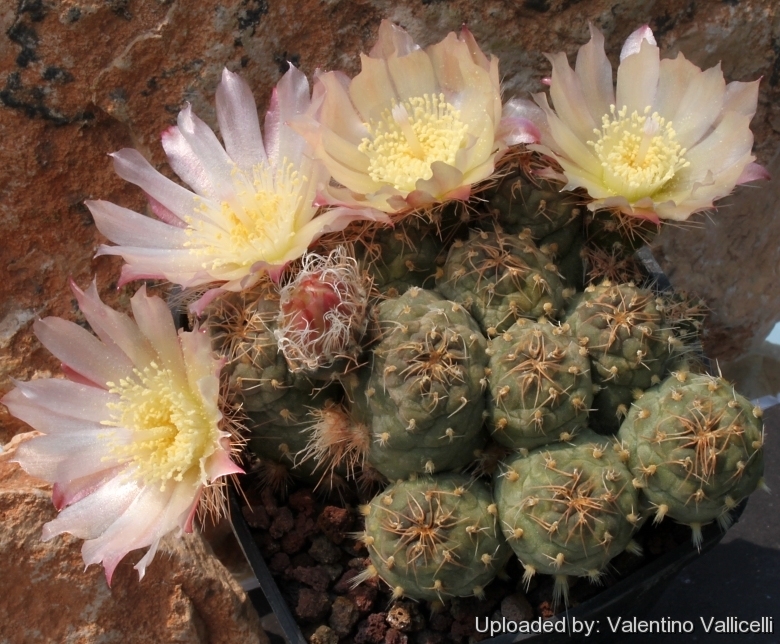
Tephrocactus subterraneus (Maihueniopsis subterranea) Photo by: Valentino Vallicelli
Origin and Habitat: Northwest of Argentina, province of Jujuy to, Potosí, Bolivia at high elevations.
Habitat: Grows not on mountain slopes but in the Punas, the plateaus of the the high Andes. This area is not so dry as that of P. clavarioides and is relatively mild and can support at least some shrubs and grasses. Altitude 3000-3500 m.
Synonyms:
See all synonyms of Maihueniopsis subterranea
back
Accepted name in llifle Database:Maihueniopsis subterranea (R.E.Fr.) E.F.AndersonCact. Succ. J. (Los Angeles) 71(6): 325. 1999 [24 Nov 1999]Synonymy: 11
back
Description: (Identifying Characteristics): Small plant geophytic opuntioid cacti with very tuberous root which in remains half buried in habitat, showing approximately 1 cm. from the ground. Plants have usually few segments (up to 6). But at the northern localities this species can grow with dozends of segments. The form "incahuasii" with greener and thinner stems forms large clumps with more than 100 heads. This species is very variable and there are many forms of Puna subterraneaSN|10776]]SN|10776]]. It looks like a small Tephrocactus, but the bloom, fruit and the seeds clearly show its autonomous nature.
Stem: Grayish-green, to brownish, round in cross section, elongate, up to 6 cm wide and (but usually less around 15-18 mm in diameter) and 2-4 cm tall. The stems reduces greatly in volume during the dry season often retracting the plant underground.
Tubercles: Rhomboidal.
Roots: This plant has deep tuberous roots with only 1 to 3 cm growing above ground level.
Spines: 1 to 7(-10) pectinated, more or less bent toward the plants body.
Glochids: None or few in the basal areoles about 1 mm long.
Leaves: The leaves are very small and fall off early.
Flowers: The blossoms 2,5 to 3 cm. long have a larger diameter than the segments is one of the reasons why Puna subterraneaSN|10776]]SN|10776]] sometimes is named 'Rebutia of the Opuntias'. At North of Argentina the colour of the blossoms is rather variable; each specimen seem to show a different colour. The flower colour ranges from brown to deep rose red to a pale yellowish rose and rare, but possible with almost white. Pericarpels without areoles but with a few scales bearing hairs and long bristles in the axils.
Blooming: Time The flowering is diurnal and takes place during the summer.
Fruit: Globose, 12-15 mm in diameter, dry indehiscent (it cannot open by itself )
Seed: 4 mm large covered with a tender arillum.
Subspecies, varieties, forms and cultivars of plants belonging to the Maihueniopsis subterranea group
 Maihueniopsis subterranea (R.E.Fr.) E.F.Anderson: Small plant with very tuberous root and grayish-green, to brownish segments usually around 15-18 mm in diameter and 2-4 cm tall. It is very variable. Distribution: Northwest of Argentina and province of Jujuy to Potosí, Bolivia.
Maihueniopsis subterranea (R.E.Fr.) E.F.Anderson: Small plant with very tuberous root and grayish-green, to brownish segments usually around 15-18 mm in diameter and 2-4 cm tall. It is very variable. Distribution: Northwest of Argentina and province of Jujuy to Potosí, Bolivia. Maihueniopsis subterranea subs. pulcherrima (Halda & Horáček) M.Lowry: has greener and thinner stems, forms large clumps with more than 100 heads and has a larger (4-6 cm) red or sometimes violet flower. Distribution: Chuquisaca, Bolivia.
Maihueniopsis subterranea subs. pulcherrima (Halda & Horáček) M.Lowry: has greener and thinner stems, forms large clumps with more than 100 heads and has a larger (4-6 cm) red or sometimes violet flower. Distribution: Chuquisaca, Bolivia.
Bibliography: Major references and further lectures
1) D. Hunt, Cactaceae Systematics Intitiatives No. 25, October 2011
2) J. J. Halda and L. Horácek, An. Mus. Richnov. Sect. Natur, 2000, 7, 75
3) Tony Roberts “Puna no more!” The Tephrocactus Study Group <http://tephro.com/index.php/the-journal/%5C%22index.php?option=com_content&view=article&id=27&catid=10&Itemid=101%5C%22>
4) Lowry, M. (2004) Tephrocactus Study Group 10(4): 55.
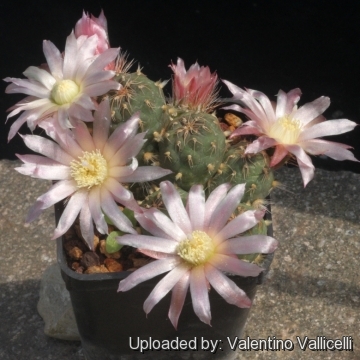 Tephrocactus subterraneus (Maihueniopsis subterranea) Photo by: Valentino Vallicelli
Tephrocactus subterraneus (Maihueniopsis subterranea) Photo by: Valentino Vallicelli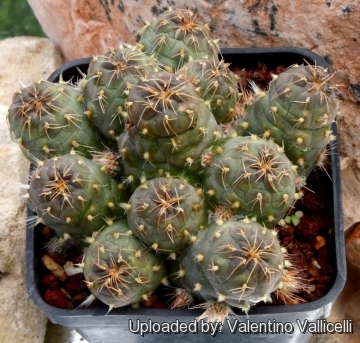 Tephrocactus subterraneus (Maihueniopsis subterranea) Photo by: Valentino Vallicelli
Tephrocactus subterraneus (Maihueniopsis subterranea) Photo by: Valentino Vallicelli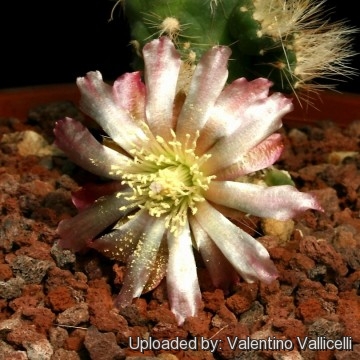 Flower up to 3 cm range from brown to whitish. (Maihueniopsis subterranea) Photo by: Valentino Vallicelli
Flower up to 3 cm range from brown to whitish. (Maihueniopsis subterranea) Photo by: Valentino Vallicelli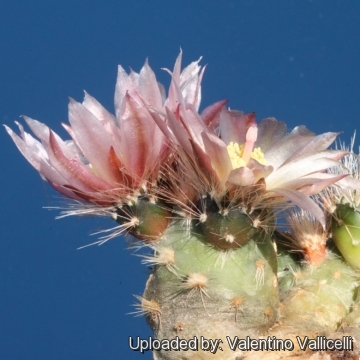 Tephrocactus subterraneus (Maihueniopsis subterranea) Photo by: Valentino Vallicelli
Tephrocactus subterraneus (Maihueniopsis subterranea) Photo by: Valentino Vallicelli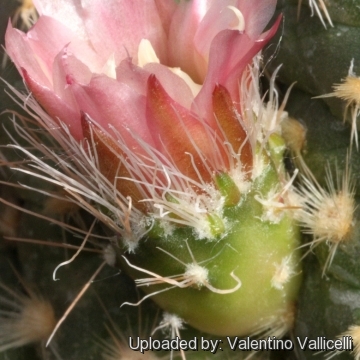 Tephrocactus subterraneus (Maihueniopsis subterranea) Photo by: Valentino Vallicelli
Tephrocactus subterraneus (Maihueniopsis subterranea) Photo by: Valentino Vallicelli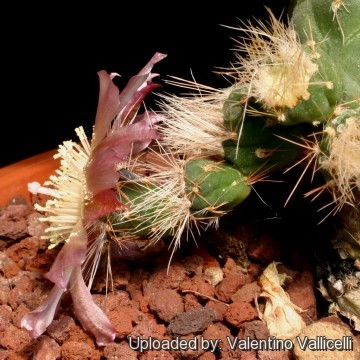 Sometime it produces flowers from the areoles on the hypantium of another flower. In the photo a chain of three flower. (Maihueniopsis subterranea) Photo by: Valentino Vallicelli
Sometime it produces flowers from the areoles on the hypantium of another flower. In the photo a chain of three flower. (Maihueniopsis subterranea) Photo by: Valentino Vallicelli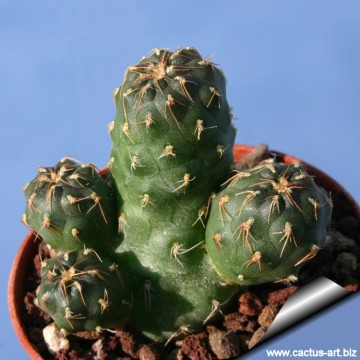 Tephrocactus subterraneus (Maihueniopsis subterranea) Photo by: Cactus Art
Tephrocactus subterraneus (Maihueniopsis subterranea) Photo by: Cactus Art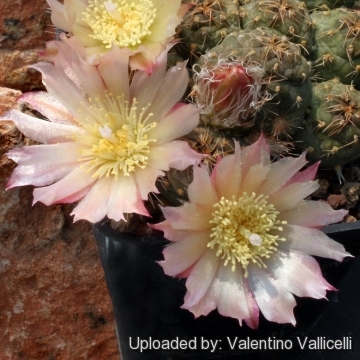 Tephrocactus subterraneus (Maihueniopsis subterranea) Photo by: Valentino Vallicelli
Tephrocactus subterraneus (Maihueniopsis subterranea) Photo by: Valentino VallicelliCultivation and Propagation: This species resists cold well if it is dry and need to be kept in a cool place during winter rest (this is important for the flowers as well as for their health) Without this cool winter period they normally wont get many buds.. This mountain cactus - because of the elongated fat taproot - necessitate deep pots and a well drained mineral potting mix. They are susceptible to overwatering, but need enough water during vegetation. Requires full sun. Specimens in culture, in special grafted ones, presents a bigger amount of glochids than the ones growing in their habitat. Need a sufficient amount of air.
Propagation: Usually propagated by cuttings and grafting . Grafted plants in culture are most common and sprout strongly. But it is also feasible to root them but they grow much slower on their own roots and takes various years prior to they bloom.
Your Photos
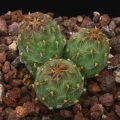
by Valentino Vallicelli
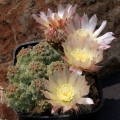
by Valentino Vallicelli
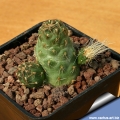
by Cactus Art





















